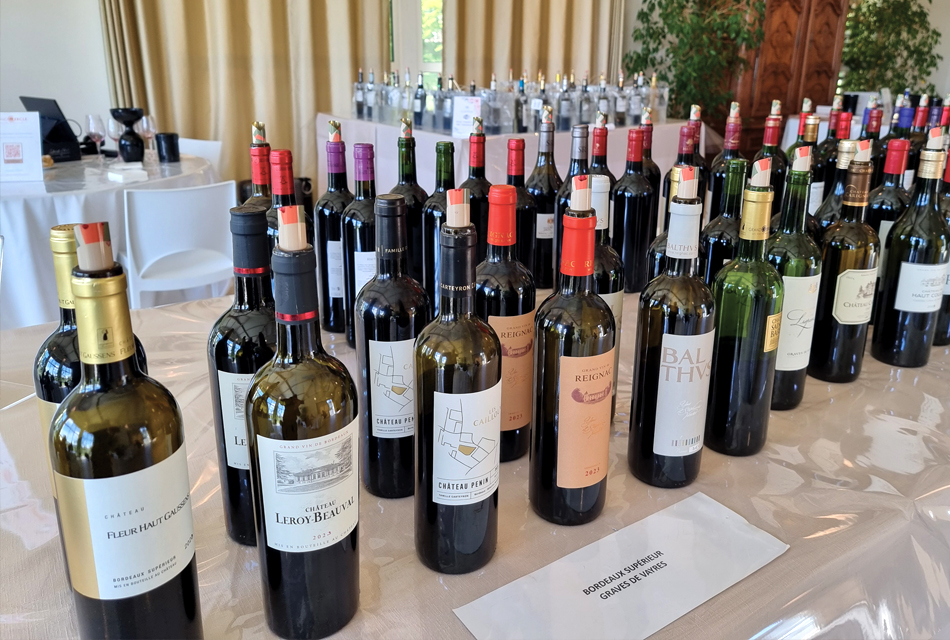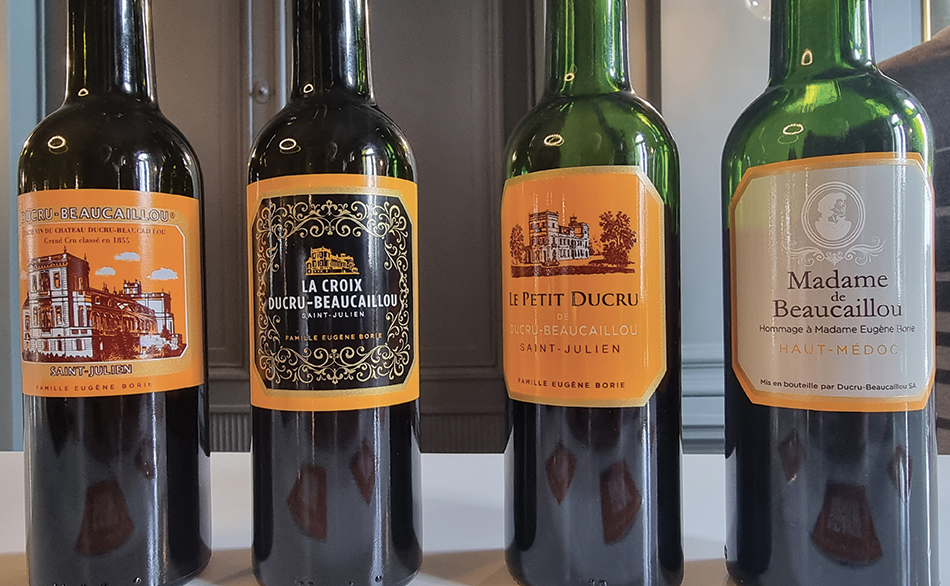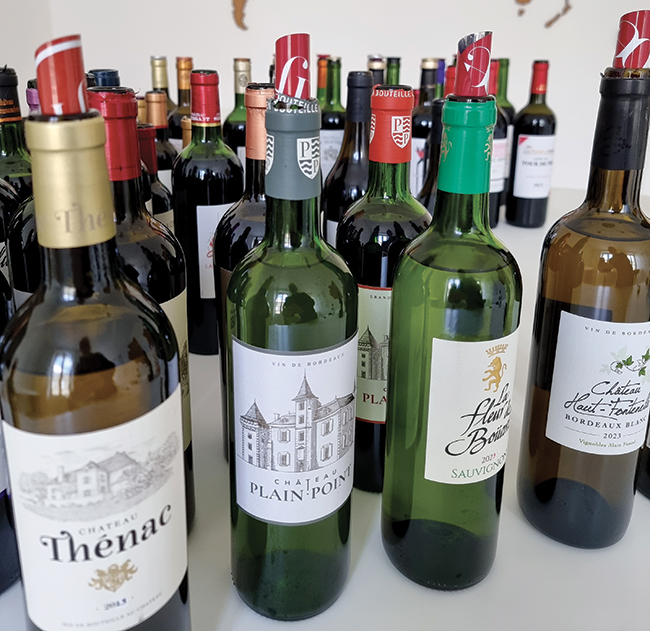
We experienced a very humid end to spring, leading Benjamin Massié of Derenoncourt Consultants to describe it as an "ultra-trail" vintage, both for organic and conventional wines, with fairly similar treatment rhythms.
In this vintage of aesthetes, one often distinguishes the actors and actresses who respected the material, both in extraction and aging. The balances, quite fragile overall, will require delicate handling. Like 2014 or 2016, 2023 presents itself as a sponge for terroir. Once again, we can confidently call it a winemaker's vintage! In essence, it's a vintage that required great adaptation, flexibility, and often a rethinking of practices, but also a real site-specific approach. There is, of course, a certain heterogeneity across the territory, between losses due to mildew and frost affecting mainly the Merlots, leading to sometimes atypical blends, ultimately resulting in a very interesting vintage for its freshness. We can speak of a Cabernet vintage, particularly Cabernet Sauvignon on the left bank. It's not an exaggeration to say that in 2023, everything was decided in the vineyard, especially the need to pay close attention to the soils as early as August. A whole reflection on cover crops that needed to be initiated as early as June.
The whites offer perfect balance. The wines are elegant and easy-drinking with moderate alcohol levels. The Sauvignon Blancs were harvested early in the last week of August. They bring forth yellow and exotic fruits and are often devoid of their vegetal character. The Semillons, usually harvested later, escaped the mid-September rains. They bring richness to the ensemble. This ultimately yields aromatic, complex, and pleasantly explosive wines.

The reds present themselves with more finesse than opulence. The grapes, with dissimilar yet complementary profiles, were able to be harvested perfectly ripe during a particularly extended harvest period. Care must be taken with the quality of the tannins to avoid excessive extraction and maintain the silkiness and roundness of the early fermentation stages. Thus, we discover wines of finesse, more classical but with a lovely depth. They are generally structured on a framework of fine and ripe tannins. The reds are generally concentrated with moderate alcohol levels. 2023 will once again reveal the great terroirs, with a preference for ripe Cabernets.
In a vintage that required some restraint, Château L’Isle Fort Cuvée Précieuse in Bordeaux stands out. The wine is lively with punctuated acidity and a very nice toasty note. The palate is fresh, almost tart. The venerable Château Penin, Bordeaux Supérieur, distinguishes itself with a silky mouthfeel. The juice is lively and already very appealing, with notes evoking cherries. In Bordeaux Blanc, Château Penin again stands out with ripe Sauvignons and very nice bitterness. A beautiful expression of terroir and craftsmanship. Château Bellevue is a pleasant surprise in Bordeaux Blanc, with a delicate nose of carnation and a ripe and suave palate.
For the red of Château Haut-Selve, the Lesgourgues family focused on expressing the freshness potential of this vintage. Here, the vegetal aspect is refined and lends freshness to the palate. On the finest gravelly slopes, Château Ferrande establishes itself as a must-have in the AOP. The expression of Merlot here is perfect: refined and fresh with a hint of sweet spices and liquorice. For Ferrande, in Graves Blanc, Julien Belle of Oenoteam has composed a much less extracted, more fluid and savory score with well-placed fruit. It's tense and ripe.
The Graves Cru Classé, Château Malartic-Lagravière, presents, in red, a nose marked by lovely Cabernet Sauvignon. The palate, balanced and finely tannic, is less powerful than graceful. Château Latour-Martillac, Classified Growth of Graves in white, plays in a register of softness. It's beautifully exotic with a concentrated palate around citrus and candied fruit notes.
A very refined parcel selection and integral vinification bring a lot of density and creaminess to Château Loudenne. The Cabernets are ripe and mellow. Château Tour Séran stands out with a more slender structure than broad, and the presence of black and red fruits with juicy acidity.
We will remember the precise and delicate score of Château de Malleret, Cru Bourgeois Exceptionnel, accompanied since 2014 by Derenoncourt Consultants. The estate, nestled in a magnificent arboreal setting, offers melting tannins that are already very integrated. It's saline. Château Charmail, Cru Bourgeois Exceptionnel, is a nice surprise with a juice already appetizing in a non-confining wood setting. We must not overlook Château Malescasse, Cru Bourgeois Exceptionnel, with notes suggesting cinnamon and powdery rose. While the palate is still a bit austere at this stage, it already reveals a nice core of fruit.
Château Marquis de Terme, Grand Cru Classé in 1855, under the technical leadership of Ludovic David, proposes to stop us with a nose of slightly smoky notes. The palate is graceful, all in red fruits and expressions of sweet almond. Château Cantenac Brown, Grand Cru Classé in 1855, presents itself with an airy suavity. While the nose summons ripe cherries, the palate is round and sensual.

Château Grand Puy-Ducasse takes the lead with a concentrated and elegant nose and on the palate flavors of crunchy red fruits. Expertly crafted. Initially all in restrained power, Château Latour distinguishes itself with the progression of red fruit aromas, from dense to very dense. It's straight and astonishingly clear.
Château La Tour de Pez, while still showing some signs of ageing with a diffuse toastiness, reveals a tremendously dynamic and fresh palate. The texture is silky, carried by lovely tannins. In a completely different register, Château La Haye appears airy and floral (white flower and rose petal), with a tight and lively palate. The palate of Château Ducru-Beaucaillou, Cru Classé 1855, is luscious and balances firm tannins with the crunch of Cabernets.
2023 is the vintage of adaptation: flexibility, efficiency, and a rethinking of practices in the vineyard and in the cellar. In January, a few days of warmth cause some concern, but the vineyard is ultimately ready for a new awakening at the expected time. Budbreak occurs in the last days of March. Water reserves are good, and the winter cold has passed. Spring frosts serve as a warning shot on April 4th and 5th, causing more fear than harm. 2023 will not be affected by frost. Soon the real enemy is identified. It revels in tropical days. The incessant rains are punctuated by clear skies and warmth, which delight in the development of mildew. Spring provided a vigorous physiological state and a significant crop load. June saw heavy rains, raising concerns about the development of mildew. The pressure will persist throughout the vegetative growth. Useful reserves are significant by mid-July, and veraison begins very early in the month. Hydric stress is slow to develop and prolongs this episode in time. This already implies heterogeneity of ripeness that we must take into account at harvest time. In summary, July saw very little rain and did not suffer from the excessive heat of summer 2022. Veraison progressed perfectly in August with great warmth, and the 25 mm of rain on August 15th were beneficial in the vineyard. The first week of September was marked by very high temperatures that favored ripening of all the berries. These continued throughout the month, allowing for a harvest tailored to the many tastings of grape berries in the vine rows. For winemakers who found the answer to mildew pressure, the 2023 vintage was generous and indulgent. The famous Bordeaux Indian summer was present, promoting optimal ripeness of grapes and good harvest conditions. In other words, all the parameters were met to produce wines that are distinctive and remarkable in many respects (freshness, balance, and complexity)

We cannot ignore Château Bellevue in Saint-Emilion Grand Cru, 100% Merlot. The nose is elegant and floral. On the palate, there's a hint of violet sprinkled with chalk. The mid-palate is juicy and crystalline. It's an expression of a beautiful limestone terroir and meticulous parcel-based approach. Château Montlabert, Grand Cru Classé of Saint-Emilion, offers a nose of beautiful smoothness and a precise woodiness. The palate, still a bit fermentary, is juicy and stretched. A great success. Château La Marzelle, Saint-Emilion Grand Cru, has a dense, sanguine, and lively juice. It's finely balanced and juicy. We were very impressed by the juicy juice, underpinned by a beautiful tannic structure of Simon Blanchard, Au Champ de la Fenêtre in Montagne Saint-Emilion. It's rooty and marked by aromatic herbs. In the same AOP, we will remember the exuberance of the Vieux Château Palon. Fresh fruits dominate the palate despite slightly tight tannins. Just and promising wood and ageing.
Château Mazerat, in Saint-Emilion Grand Cru, is marked on the palate by a still fairly firm wood intake, but the second wine of Dôme has a beautiful energy around very ripe black fruits. It has no reason to envy its big brother.
The nose of Château Croix de Labrie, Saint-Emilion Grand Cru, is almost maritime. The texture is slender yet powerful. The tannins are finely integrated. The finish is digestible and saline.
Château Mazeyres charms with the purity of flesh from a myriad of black fruits. Precise ageing brings subtlety and indulgence to this great Pomerol. Clos Vieux Taillefer imposes itself with evanescent notes of rose petal and peony. The still somewhat "stiff" finish nonetheless reveals lovely notes of bark and dried leaves.
Château La Croix-Lartigue is a remarkable representative of the limestone plateaus of Castillon. Flowers and flower essences greet you on the nose, and the palate, no less, surprises with its complexity. Spices and chili energize the juice. Clos Puy Arnaud needs no introduction with its fresh stem and fruit nose. The finely textured juice is radiant and flavorful on the palate, around cherry notes. A cheerful wine.

We appreciate the elegance of Château La Dauphine with its subtle violet notes. While the fruit is still somewhat contained, we appreciate the clarity of the aromas and the density of the mid-palate. Château Dalem, in a slightly more vegetal register, is straightforward without frills, where the heart of the fruit delicately enhances the finish.

We cannot overlook Château Toulouse, the flower of the small appellation Graves de Vayres. The nose is floral and enveloping, with notes of violet. The saline and clear palate has particularly well-integrated tannins. The Grand Vin of Château Lesparre displays lacteous notes on the nose, from which emerge beautiful fragrances of black fruits and foliage. The palate (barely fermentary) invites a stroll in the undergrowth. Lovely juice.
Château de Grissac is a beautiful addition to the Derenoncourt Consultants catalog. It's a wine of place and limestone. Black fruits dominate the palate initially before floral and spicy notes arrive, between violet and rose petal. Château Mondésir Gazin has an almost southern nose with this hint of stimulating vegetal notes. Floral and spicy expressions energize the palate.
Text and photos : Henry Clemens